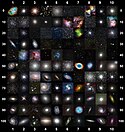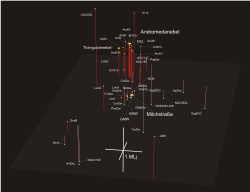M31 (panorama) - Noirlab1910a
The globular clusters studied (lower right insets), indicated by colored circles, are located in the outer halo of the Andromeda Galaxy, beyond the bright disk of the galaxy (upper left inset). The star clusters separate into two groups — those associated and unassociated with stellar streams — that have very different orbits, a result that points to two discrete migration events in the history of the galaxy. The color of each circle indicates the line-of-sight velocity of the corresponding star cluster.
Credit:
Australian National University/NOIRLab/NSF/AURAThis media was created by the National Optical-Infrared Astronomy Research Laboratory (NOIRLab).
Their website states: "Unless specifically noted, the images, videos, and music distributed on the public NOIRLab website, along with the texts of press releases, announcements, images of the week and captions; are licensed under a Creative Commons Attribution 4.0 International License, and may on a non-exclusive basis be reproduced without fee provided the credit is clear and visible." To the uploader: You must provide a link (URL) to the original file and the authorship information if available. | |
Diese Datei ist lizenziert unter der Creative-Commons-Lizenz „Namensnennung 4.0 international“.
| |
Relevante Bilder
Relevante Artikel
AndromedagalaxieDie Andromedagalaxie, auch (veraltet) Andromedanebel oder Großer Andromedanebel genannt, ist mit rund 2,5 Millionen Lichtjahren Entfernung die am nächsten zur Milchstraße gelegene Spiralgalaxie. Sie ist zugleich das entfernteste Objekt, das unter guten Bedingungen ohne technische Hilfsmittel mit bloßem Auge beobachtet werden kann. Sie liegt im Sternbild Andromeda, von dem sie ihren Namen erbt. Häufig wird sie auch kurz als M31 bezeichnet nach ihrem Eintrag im Messier-Katalog. .. weiterlesen




















